Babyface
By Alice Urbino
Flesh Press
Dew came into this world in a traumatic birth moment where her disfigurement was not taken gracefully by her parents, and it’s admittedly not a standard one, more like a partially-formed face growing into its own. Dew feels the moment of her birth constantly, as some kind of crippling weight that prevents her from moving past the trauma. As she says, she feels like she’s an alien, and though her well-meaning mother encourages Dew’s involvement with other people her age, it’s with understandable hesitation that Dew consents to follow-through.
She gives in, attending a classmate’s birthday party, and her hesitation to join in is justified when the public revelation of her disfigurement causes humiliation. But it also leads to an unexpected connection that challenges her view of herself and demands uncomfortable self-examination. New friendship becomes an unexpected road to transformation.
Urbino has a fascination with the grotesque in her work — one of her offerings in her store is a little pin of the Eraserhead baby — but in Babyface, she doesn’t use it for horror, but fuzzy feelings of self-empowerment. Compare that to a recent minicomic of hers, Blindenhund — translated from German, that means “guide dog” — that takes the idea of coexistence in order to aid to a logical gruesome conclusion that’s as strangely sweet as it is grotesque.
The way Urbino ushers Dew along in her journey is touching, warm, and also amusing, with aspects of it reminding me of the wonderful Swedish film Border, and comics by Charles Forsman, who typically touches on the outsider teenager’s desire for connection and understanding. But the complete package is definitely all Urbino.
In Babyface, Urbino uses her body horror themes to offer empowerment against ableism and to examine that delicate balance in which you can accept your disability as a crucial aspect of yourself, but at the same time not allow it to overtake your identity. The struggle for Dew is rectifying what she sees in her new friend — not only a pride in the condition but a tendency to, in Dew’s eyes, make a spectacle of it — with her fears of being different and not belonging. It’s probably a balance many of us try to find as we mature but in Dew’s case, self-care collides with societal prejudice, and Urbino depicts that with surprising tenderness.
Gogor #1
By Ken Garing
Image Comics
I think we all know the fantasy epic formula at this point. Person in cloistered existence — perhaps they’re naive, sometimes they want to get out of their cloistered existence, in which case they are untested — is faced with extraordinary circumstances that disrupt the cloistered existence — this usually comes in the form of an invasion or some kind of marauders — and forces the person into a mission to save the cloistered existence at the urging of a mentor. This mission often involves an object that must be protected, a place or person that must be reached, and company for the person in the form of someone from the other side of the tracks who also acts as a guide in the strange new world the person has entered. During the mission, the person grows up, faces tests, and transforms into something more than they were when we first met them.
Does that sound about right?
Gogor pretty much fulfills that story structure but at least it does so in a fun way and features enough little flourishes that even if it follows the familiar plot path, it might do so with a few delightful surprises along the way.
Young Armano is being chased by some aggressive guys on giant ants. Armano speeds along mounting a giant shrew. Charged by his teacher with protecting a mysterious scroll after his school is attacked by the aggressive guys on giant ants, Armano lives on a series of floating islands that you can only travel across if you ride a flying creature or happen to have a giant shrew that’s really good at jumping. Or maybe the creatures aren’t giant, maybe the humans are tiny. That’s a definite possibility here.
What you figure happens next pretty much happens next, but I’m here to tell you that the result of the mission raises more interesting plot prospects than many results of following the fantasy epic formula. The ending also implies that it might veer off a little bit. Which is to say, this is a fun debut that hints it might continue to be so by taking its readers to some unexpected situations.
Nobody Is In Control #1
Written by Patrick Kindlon
Illustrated by Paul Tucker
Lettered by Wallace Ryan
Black Mask Studios
I remember when conspiracy theories were largely kept to the fringes and in order to access them you had to at least be able to invest in a self-addressed-stamped-envelope. No longer. Those ideas are all over the internet, coming at us through mainstream radio and television, and settling happily in our current president’s brain, waiting to be spewed out by his strange little mouth. And the more the conspiracies have been opened up to normal people, the stranger they have gotten.
Nobody Is In Control takes this situation to heart when retired radio host Richard intercepts some guy named Nick crossing through his property in the middle of nowhere Georgia. Richard tries to ascertain what in the world a guy in a nice suit, carrying a briefcase, is doing in the middle of the woods, and what ensues is a roundabout conversation that doesn’t get to the truth as Richard understands it, but circles around it by becoming a babble of conspiracy facts out of Nick’s mouth.
The problem is that Richard’s radio show focused on conspiracies, but he didn’t believe any of it, thinking of himself more as a foil to the believers. And so he’s a skeptic who’s well-versed in the material he doubts and facing it in the persona of a guy who comes off as an unhinged traveling salesman. But this unhinged traveling salesman is leading Richard further into the wilderness — literally so, and also figuratively as his claims and diatribes become more convoluted and pointing to wider allegations.
With an Alex Toth-like art presentation and a fairly engaging conversational style applied to the information dump that this first issue really amounts to, Nobody Is In Control ends up being pretty intriguing. Not just for the anything-but-the-kitchen-sink presentation of conspiracy theories, but for a bizarre mix of intensity and breeziness that is employed, and also the multiple little factoids that are spread throughout the conversation. If the story can live up to the elements utilized to tell it, we might have something here.











Alas, Border isn’t out on DVD on Australia; but thanks for the tip
Comments are closed.